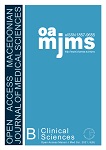The Association Between Nutritional Status and Risk of Developmental Disorder in Children in Denpasar Bali Indonesia
DOI:
https://doi.org/10.3889/oamjms.2021.6474Keywords:
Children, Nutritional status, Possibility of developmental disorderAbstract
BACKGROUND: Preschool age is an important period for growth and development. Malnutrition that occurs during this period can have negative impacts on growth, cognitive development, and academic performance in children.
AIM: The objective of the study is to know the association between nutritional status and the risk of developmental disorder in preschool children in Denpasar.
METHODS: An observational analytic study with a cross-sectional design and cluster sampling method was conducted on children under 5 years old who attended Early Childhood Education in Denpasar Bali in 2019.
RESULTS: From 468 samples, the median age was 5 years old (range, 1–5), the majority of children were well-nourished (52.6%), and caretaken by parents (82.9%). Child development was prescreened using an Indonesian child development pre-screening questionnaire/Kuesioner Pra Skrining Perkembangan (KPSP) that had 75% sensitivity, 99.16% specificity, 85.71% positive predictive value,and 98.33% negative predictive value compared to Capute Scale test as a gold standard. It showed that the majority of participants had an appropriate developmental stage (91.3%), followed by doubtful (5.3%) and possible deviations (3.4%). The results of the bivariate analysis showed that malnutrition was significantly related to the risk of developmental delay (PR 2; confidence interval [CI] 95%, 1.05-3.97). The result of multivariate analysis for variables that were considered to be significant as a risk for developmental disorder showed that malnutrition was related to the possibility of developmental disorder (PR 2; CI 95%, 1.04–3.95). Caretakers other than parents and lack of physical activity were not significantly related to the risk of developmental disorder.
CONCLUSION: Malnutrition was found to be significantly associated with the risk of developmental disorder in preschool children. Further prospective study by standard assessment tools is required to evaluate the association between nutritional status and developmental level in children.Downloads
Metrics
Plum Analytics Artifact Widget Block
References
Bolajoko MR. Growth pattern and nutritional status of under five children in Owo local government area of Ondo state, Nigeria. IOSR J Pharm Biol Sci. 2013;5(4):106-9. https://doi.org/10.9790/3008-054106109 DOI: https://doi.org/10.9790/3008-054106109
Hurley KM, Yousafzai AK, Lopez-Boo F. Early child development and nutrition: A review of the benefits and challenges of implementing integrated interventions. Adv Nutr. 2016;7(2):357-63. https://doi.org/10.3945/an.115.010363 PMid:26980819 DOI: https://doi.org/10.3945/an.115.010363
Rosales FJ, Reznick JS, Zeisel SH. Understanding the role of nutrition in the brain and behavioral development of toddlers and preschool children: Identifying and overcoming methodological barriers. Nutr Neurosci. 2009;12(5):190-202. https://doi.org/10.1179/147683009x423454 PMid:19761650 DOI: https://doi.org/10.1179/147683009X423454
Kusuma IR, Salimo H, Sulaeman ES. Path analysis on the effect of birth weight, maternal education, stimulation, exclusive breastfeeding and nutritional status toward motor development of children aged 6-24 months in Banyumas regency. Matern Child Health J. 2017;2(1):64-75. https://doi.org/10.26911/theicph.2017.096 DOI: https://doi.org/10.26911/theicph.2017.096
Diana FM. Pemantauan perkembangan anak balita. J Kesehatan Masyarakat. 2010;4:116-29.
Wani YA, Wilujeng CS, Rahmi Y. Kusuma TS, Rahmawati W, Fadhilah E, et al. Survei status gizi dan perkembangan anak balita menggunakan kuesioner praskrining perkembangan (KPSP). Majalah Kesehatan FKUB. 2017;4(4):193-9. https://doi.org/10.21776/ub.majalahkesehatan.2017.004.04.23 DOI: https://doi.org/10.21776/ub.majalahkesehatan.2017.004.04.23
Rosela E, Hastuti TP, Triredjeki H. Hubungan status gizi dengan perkembangan anak usia 1 sampai 5 tahun di kelurahan Tidar Utara, kota Magelang. Jurnal Keperawatan Soedirman. 2017;12:27-37. https://doi.org/10.20884/1.jks.2017.12.1.686 DOI: https://doi.org/10.20884/1.jks.2017.12.1.686
Ariati NN, Fetria A, Padmiari IA, Purnamawati AA, Sugiani PP, Suarni NN. Description of nutritional status and the incidence of stunting children in early childhood education programs in Bali-Indonesia. Bali Med J. 2018;7(3):723-26. https://doi.org/10.15562/bmj.v7i3.1219 DOI: https://doi.org/10.15562/bmj.v7i3.1219
Trisna Windiani IG, Sugitha Adnyana IG, Soetjiningsih I. The sensitivity and specificity of kuisioner praskrining perkembangan to detect delayed developmental in children. Am J Pediatr. 2020;6(1):42-5. https://doi.org/10.11648/j.ajp.20200601.17 DOI: https://doi.org/10.11648/j.ajp.20200601.17
Gunawan G, Fadlyana E, Rusmil K. Hubungan status gizi dan perkembangan anak usia 1-2 tahun. Sari Pediatri. 2011;13:142-6. https://doi.org/10.14238/sp13.2.2011.142-6 DOI: https://doi.org/10.14238/sp13.2.2011.142-6
Riset Kesehatan Dasar (Riskesdas). Badan Penelitian dan Pengembangan Kesehatan Kementrian RI Tahun; 2018. Available from: http://www.depkes.go.id/resources/download/infoterkini/materirakorpop2018/Hasil%20Riskesdas%202018.pdf. [Last accessed on 01 Dec 2020].
Arini D, Mayasari AC, Rustam MZ. Gangguan perkembangan motoric dan kognitif pada anak toddler yang mengalami stunting di wilayah pesisir Surabaya. J Health Sci Prev. 2019;3(2):122-8. https://doi.org/10.29080/jhsp.v3i2.231 DOI: https://doi.org/10.29080/jhsp.v3i2.231
Santrock JW. Perkembangan Anak. 7th ed. Jakarta: Erlangga; 2011.
Wiyani A. Save Our Children from School Bullying. Jogjakarta: Arrus Media; 2012.
Dhamayanti M. Kuesioner praskrining perkembangan (KPSP) anak. Sari Pediatri. 2006;8:9-15. https://doi.org/10.14238/sp8.1.2006.9-15 DOI: https://doi.org/10.14238/sp8.1.2006.9-15
Blossner M, Onis MD. Malnutrition. Envirn Burden Dis Series. 2005;12:1-43.
Mugianti S, Setijaningsih T, Fransiska K. Perkembangan motorik balita obesitas usia 3-5 tahun. J Ners Kebidanan. 2018;5:46-52. https://doi.org/10.26699/jnk.v5i1.art.p046-052 DOI: https://doi.org/10.26699/jnk.v5i1.ART.p046-052
Riset Kesehatan Dasar (Riskesdas). Badan Penelitian dan Pengembangan Kesehatan Kementrian RI; 2013. Available from: http://www.depkes.go.id/resources/download/general/Hasil%20Riskesdas%202013.pdf. [Last accessed on 01 Dec 2020].
Jimoh AO, Anyiam JO, Yakubu AM. Relationship between child development and nutritional status of under-five Nigerian children. South Afr J Clin Nutr. 2018;31(3):50-4. https://doi.org/10.1080/16070658.2017.1387434 DOI: https://doi.org/10.1080/16070658.2017.1387434
Soetjiningsih. Tumbuh Kembang Anak. Jakarta: ECG Penerbit Buku Kedokteran; 2010.
Departemen Kesehatan RI. Pedoman Pelaksanaan Stimulasi. Deteksi dan Intervensi Dini Tumbuh Kembang Anak di Tingkat Pelayanan Kesehatan Dasar. Jakarta: Depkes RI; 2009. https://doi.org/10.25077/jka.v8i4.1133 DOI: https://doi.org/10.25077/jka.v8i4.1133
Glascoe FP, Dworkin PH. The role of parents in the detection of developmental and behavioral problems. Pediatrics. 1995;95(6):829-36. PMid:7539122
Latifah EW, Krisnatuti D, Puspitawati H. Pengaruh pengasuhan ibu dan nenek terhadap perkembangan kemandirian dan kognitif anak usia prasekolah. Jur Ilm Kel Kons. 2016;9(1):21-31. https://doi.org/10.24156/jikk.2016.9.1.21 DOI: https://doi.org/10.24156/jikk.2016.9.1.21
World Health Organization. New WHO Guidelines on Physical Activity, sedentary Behaviour and Sleep for Children Under 5 Years of Age. A review. Geneva: World Health Organization; 2019.
American Academy of Pediatrics. Identifying infants and young children with developmental disorders in the medical home: An algorithm for developmental surveillance and screening. Pediatrics. 2016;118(1):405-20. https://doi.org/10.1542/peds.2006-1231 PMid:16818591 DOI: https://doi.org/10.1542/peds.2006-1231
Perdana SA, Medise BE, Purwaningsih EH. Duration of watching TV and child language development in young children. Paediatr Indones. 2017;57(2):99-100. DOI: https://doi.org/10.14238/pi57.2.2017.99-103
Downloads
Published
How to Cite
Issue
Section
Categories
License
Copyright (c) 2020 I Gusti Ayu Trisna Windiani, Ni Kadek Wiwik Agustini, I. Gusti Agung Ngurah Sugitha Adnyana, Soetjiningsih Soetjiningsih, Ni Luh Sukma Pratiwi Murti (Author)

This work is licensed under a Creative Commons Attribution-NonCommercial 4.0 International License.
http://creativecommons.org/licenses/by-nc/4.0








